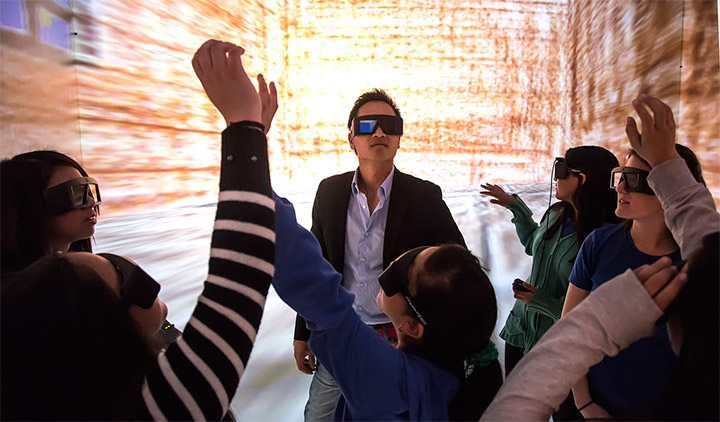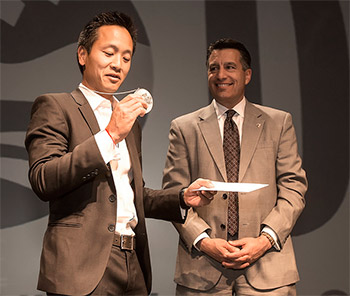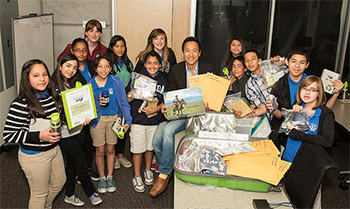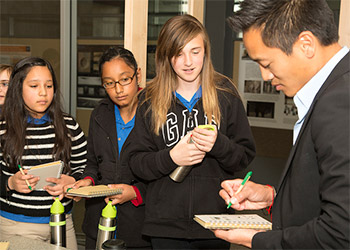Scientists Discover a New Signaling Pathway and Design a Novel Drug for Liver Fibrosis
Health & Behavior

Elementary school students ask questions of UC San Diego's Albert Lin in front of a virtual-reality display at the Desert Research Institute in Reno.
Albert Yu-Min Lin may now be even better known in Nevada than he is in his home state of California. The research scientist from the Qualcomm Institute at the University of California, San Diego was in Nevada in late March to accept the 27th Desert Research Institute (DRI) Nevada Medal. Lin was cited for “his pioneering work in a new era of digital exploration and science education through public engagement.” At 33, Lin – a three-time alumnus of UC San Diego in materials science and engineering (Ph.D. ’08) and electrical engineering (BS ’04, MS ‘06) – is the youngest research scientist and the first materials scientist and engineer to receive the Nevada Medal.
Specifically, Lin was recognized for technology-enabled exploration and the power of the crowd in his search for the lost burial site of Genghis Khan.
“I was honored to receive the medal and even more delighted by the related events across the state where I was able to talk about exploration and technology to people ranging from school children and business leaders to the Governor,” said Lin, who was also profiled by most of Nevada’s leading newspapers and TV stations.
The Nevada Medal was established by DRI in 1988 to acknowledge outstanding achievement in science and engineering. The annual award includes an eight-ounce minted medallion of .999 pure Nevada silver and $20,000 lecture honorarium.
Lin is in good company. Recent recipients of the Nevada Medal included James Hansen, Director of the NASA Goddard Institute for Space Studies; Francis Collins, current director of the National Institutes of Health; ocean explorer Robert Ballard, a National Geographic Explorer in Residence best known for discovering the Titanic in 1985; and Steven Squyres, who was the scientific principal investigator on the Mars Exploration Rover Project.

Albert Yu-Min Lin accepting the 27th Desert Research Institute Nevada Medal from Gov. Brian Sandoval in Las Vegas. A second medal ceremony took place in Reno.
The 2014 award program involved public lectures by the medalist at DRI campuses in Reno and Las Vegas, and the award was formally presented by Gov. Brian Sandoval not once, but twice, during dinner ceremonies in the state’s two leading cities. The formal dinners were attended by Nevada's business, educational and governmental elite.
“Dr. Albert Lin provided one of our most engaging presentations to date,” said DRI president Steve Wells, later telling a TV interviewer, “This is where we want science to go in the State of Nevada, to fulfill the governor’s goal of developing an innovation-based economic development, and [Lin] epitomizes that.”
Added Wells: “His work has motivated participation from hundreds of thousands of people in real-time, on-the-ground scientific discovery in ways we never imagined.”
Lin’s pioneering work to create new methods for massive data analysis through innovative crowdsourcing techniques earned him the 2011 USGIS Academic Achievement award, and his National Geographic project became the subject of a documentary, “Forbidden Tomb of Genghis Khan.”
“To me the Nevada Medal comes with the heavy responsibility of honoring the spirit of human curiosity… the desire to seek the unknown, stand at its bank, and venture in,” said Lin, who holds a Ph. D. in Materials Science and Engineering, as well as BS and MS degrees in Electrical Engineering, all from UC San Diego’s Jacobs School of Engineering. “Today the frontiers of exploration exist in science, driven by a need to expand our knowledge of the world around us, and defined by how we utilize that knowledge. I am humbled and incredibly honored to be a small part of that.”
At the Medal gala in Reno, the audience included dignitaries, among them the state’s treasurer, secretary of state, lieutenant governor, and Governor Brian Sandoval, who confessed to the audience that after realizing that the honoree had already started one company, “I told him that he’s got to move here” to be part of Nevada’s two-year-old innovation- and opportunity-focused economic development plan.
Introducing Lin in Reno, DRI president Wells called him “Indiana Jones 2.0… a pioneer in the new wave of science education.” Lin visited elementary schools in both Reno and Las Vegas, where he talked about the excitement of science and exploration. Referring to the students, Lin said: “These are the people who make me feel like going to work every day.”

Lin with students unpacking a DRI Green Box. Developed for K-12 educators, Green Boxes introduce environmentally focused topics that emphasize sustainable practices and natural resource conservation. Each Green Box contains the material and curriculum needed to engage students in hands-on activities with real-life applications that are both informative and fun.
At Kate Smith Elementary School in Reno, Lin found a receptive audience of would-be explorers. “If in some small part, when I talk to them, it allows them to become the explorers of tomorrow, then that’s what I’m here about,” he told a reporter afterwards. “The age of exploration is today, maybe more so than ever, because of the information, tools and data that we have at our fingertips. If they get involved, the power of that collective effort can be profound.”
Lin told the audience that after creating a system to allow the public to participate in his search for the tomb of Genghis Khan, it became clear that crowdsourcing was ushering in a new era for citizen science. “At a very small cost, we garnered 18.1 years worth of human effort,” he said.
Said Lin: “Curiosity is a tradition and we innovate to fulfill that tradition.”
Following the crowdsourcing effort, Lin led high-tech expeditions to Mongolia, where his team used unmanned aerial vehicles, ground penetrating radar, magnetometry and other geo-physical instrument to investigate the most promising destinations observed by the crowd. “We looked at over 100 different sites, and 55 of them were Bronze Age tombs,” he told the rapt audience. At one historically significant location, identified by the Mongolian government as the country’s most sacred mountain, “trees were falling down, and the roots of these trees brought up ceramic pieces, including one with the face of a lion, and as we began walking on the plateau, we could hear ceramics crunching under foot, and it became clear that we were walking on the tiled roof of a structure.”
Using radiocarbon dating, horse bones found at the site were dated to around the time 800 years ago when Genghis Khan died.
Until recently, Lin was asked by the Mongolian government not to publish his findings from the restricted area, pending a formal petition to the World Heritage Committee of UNESCO to recognize and protect the sacred mountain, Burkhan Khaldun, as a World Heritage Site. The government has now lifted the restriction and given Lin permission to publish his research, so he is now preparing a manuscript about the non-invasive search and findings, for publication later this year.
Lin and colleagues on the Genghis Khan project later founded Tomnod, a company that commercialized the use of satellite imagery and crowdsourcing to assist in applications ranging from humanitarian monitoring to search and rescue. The company was recently acquired by a satellite imaging company, the Colorado-based Digital Globe. Lin opted to remain in San Diego, accepting a role on the Board of Directors of the Digital Globe Foundation. His Tomnod colleagues moved to Digital Globe, and soon after faced the greatest challenge to its system: the recent disappearance of a Malaysian Airlines plane. “As of last week, over four million people had logged on to the website to help in the search for the Malaysian airliner,” Lin told the audience after receiving his medal.

Students from Kate Smith Elementary School ask for Lin's autograph after a Q&A session.
In 2013 Lin launched the Distributed Health Labs in the Qualcomm Institute at UC San Diego, which is developing a Tricorder-type, all-in-one device with apps for monitoring an individual’s vital signs and environmental exposures.
More recently, he is a co-founder of Earthnet, which is building a game-based simulation of the Earth for “imagineering the perfect planet” merging citizen science and online games to rethink engagement in earth-science education. Earthnet was launched by former National Geographic Society president Tim Kelly, Lin, and fellow co-founders Vijay Lakshman, a world-class game developer, and John Gamba, an education-technology entrepreneur.
“We innovate to fulfill our curiosity, but we need to know why,” Lin told the Reno audience. “And I think what you’re doing here at DRI represents the very best of our intentions to understand what and why we need science.”
DRI conducts cutting-edge applied research in air, land and life, and water quality across Nevada, the U.S. and across the world. The institute has more than 60 specialized research laboratories providing the highest quality service, specializing research, technology and development and improving the understanding of Earth’s environment.
Keep up with all the latest from UC San Diego. Subscribe to the newsletter today.